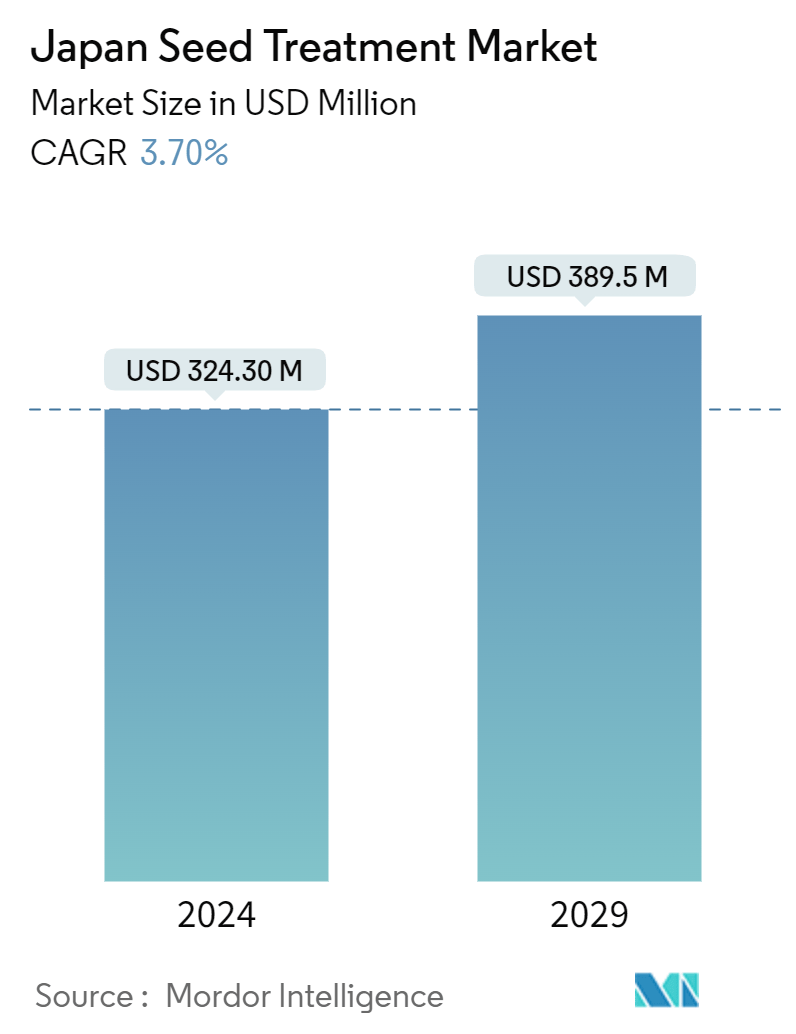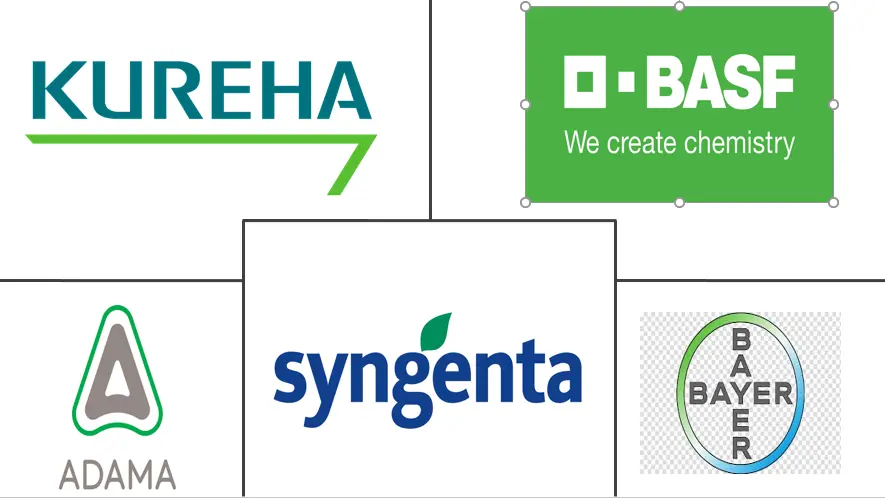Market Size of Japan Seed Treatment Industry

| Study Period | 2019 - 2029 |
| Base Year For Estimation | 2023 |
| Market Size (2024) | USD 324.30 Million |
| Market Size (2029) | USD 389.5 Million |
| CAGR (2024 - 2029) | 3.70 % |
| Market Concentration | High |
Major Players
*Disclaimer: Major Players sorted in no particular order |
Japan Seed Treatment Market Analysis
The Japan Seed Treatment Market size is estimated at USD 324.30 million in 2024, and is expected to reach USD 389.5 million by 2029, growing at a CAGR of 3.70% during the forecast period (2024-2029).
Seed treatment is the application of chemical ingredients to the seed to ensure seed protection by suppressing, controlling, or repelling plant pathogens, insects, or other pests that attack seeds, seedlings, or plants. It also enables seed enhancement by improving their performance post-harvesting and conditioning them before they are sown. The factors driving the Japan seed treatment market include: rise in the cost of high-quality seeds, such as GM and hybrid, an increase of limitations associated with soil and foliar application of crop protection products, increasing need for efficient post-harvest seed storage, high disease pressure and need for increased agricultural productivity and improving seed technology. While rapid growth is expected to be witnessed in the coming years, a few factors, such as the increasing role of chemicals in affecting the environment adversely, limited dose capacity, protection and shelf life of treated seeds, phytotoxicity associated with the use of seed treatment chemicals and lack of awareness among the farmers, are hindering the market growth.
Japan Seed Treatment Industry Segmentation
The corporations in seed treatment operate in B2B, as well as B2C business format. The Japanese seed treatment market is segmented by function(fungicide, insecticide, and nematicide) and crop type (commercial crops, fruits and vegetables, grains and cereals, pulses and oilseeds, and turf and ornamental crops).
| By Function | |
| Fungicide | |
| Insecticide | |
| Nematicide |
| Crop Type | |
| Commercial Crops | |
| Fruits and Vegetables | |
| Grains and Cereals | |
| Pulses and Oilseeds | |
| Turf and Ornamental crops |
Japan Seed Treatment Market Size Summary
The Japanese seed treatment market is experiencing significant growth, driven by the increasing need for efficient agricultural practices and the rising costs associated with high-quality seeds, such as GM and hybrid varieties. Seed treatment involves applying chemical or biological agents to seeds to protect them from pests and diseases, enhancing their performance post-harvest. This method is becoming more popular due to regulatory restrictions on traditional crop protection methods and the need to improve agricultural productivity. Despite its growth potential, the market faces challenges, including environmental concerns related to chemical use, limited effectiveness of treated seeds, and a lack of awareness among farmers about the benefits of seed treatment.
In Japan, rice is a major crop, and seed treatment is crucial for protecting it from various pests and diseases. The market is dominated by key players like Adama Agricultural Solutions, BASF SE, Bayer Cropscience Ag., Syngenta Co. Ltd., and Kureha Corporation, which together hold a significant share of the market. These companies benefit from strong marketing and innovation capabilities, catering to a loyal customer base. As the demand for high-quality seeds continues to rise, both companies and farmers are willing to invest in seed treatment solutions to safeguard their investments in costly seeds, further propelling market growth.
Japan Seed Treatment Market Size - Table of Contents
-
1. MARKET DYNAMICS
-
1.1 Market Overview
-
1.2 Market Drivers
-
1.3 Market Restraints
-
1.4 Porter's Five Force Analysis
-
1.4.1 Bargaining Power of Suppliers
-
1.4.2 Bargaining Power of Buyers/Consumers
-
1.4.3 Threat of New Entrants
-
1.4.4 Threat of Substitutes
-
1.4.5 Degree of Competition
-
-
-
2. MARKET SEGMENTATION
-
2.1 By Function
-
2.1.1 Fungicide
-
2.1.2 Insecticide
-
2.1.3 Nematicide
-
-
2.2 Crop Type
-
2.2.1 Commercial Crops
-
2.2.2 Fruits and Vegetables
-
2.2.3 Grains and Cereals
-
2.2.4 Pulses and Oilseeds
-
2.2.5 Turf and Ornamental crops
-
-
Japan Seed Treatment Market Size FAQs
How big is the Japan Seed Treatment Market?
The Japan Seed Treatment Market size is expected to reach USD 324.30 million in 2024 and grow at a CAGR of 3.70% to reach USD 389.5 million by 2029.
What is the current Japan Seed Treatment Market size?
In 2024, the Japan Seed Treatment Market size is expected to reach USD 324.30 million.

